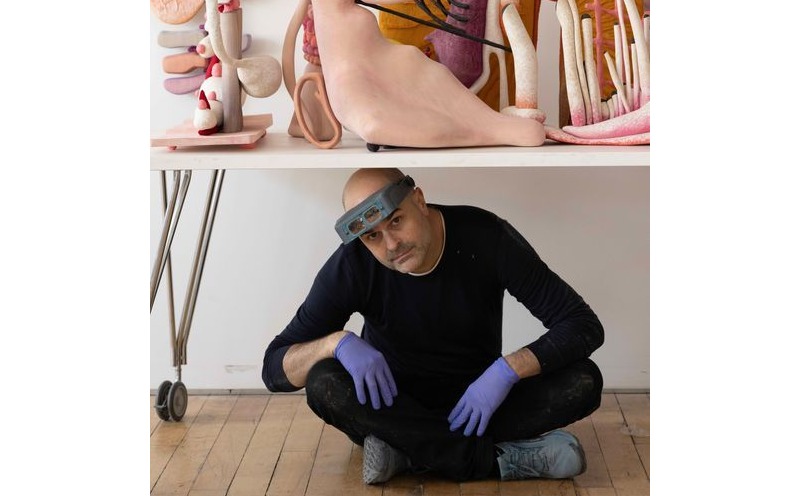
The Subconscious and the Algorithm
Alexander Burenkov
On Intuition, AI, and the Future of Sculpture / A Conversation with New York-based artist Matthew Ronay
In an age increasingly defined by frictionless screens, algorithmic substitution, and dematerialized experience, Matthew Ronay’s sculptures resist the gravitational pull of the virtual with a kind of ecstatic physicality. His current exhibition, Thirteen Forms, at Perrotin Paris (June 5–July 26, 2025), stages a tactile counterpoint to the abstraction of post-digital culture, offering a bodily grammar of resistance rooted in intuition and automatic writing. Comprising ten hand-carved sculptures and three wall reliefs, the show hinges on Ronay’s enduring preoccupations with the subconscious and the metabolic, reimagined through the lens of networked systems and artificial cognition.
At first glance, Ronay’s vividly dyed basswood objects may seem otherworldly, even whimsical, with their soft gradients and undulating silhouettes. But their aesthetic strangeness is firmly anchored in an embodied lexicon—digestive tracts, orifices, seedpods, wounds, tongues—rendered with almost devotional attention to craft. His forms feel excavated from some interior terrain, biological yet mythic, as if grown rather than made. It’s no surprise that Ronay’s process begins with automatic drawing, a technique historically linked to Surrealism and the psychoanalytic model of the unconscious. What’s more surprising is how this intuitive method becomes a tool to navigate the disembodied logic of contemporary techno-culture.
Ronay speaks of orifices not merely as anatomical sites but as existential thresholds: places where the self meets the world, where fluids and signals pass in both directions. These portals—be they mouths, wounds, data inputs—are central to his exploration of the post-digital condition. His work frequently flirts with the aesthetics of interface: the in-between, the unseen, the systemic. What emerges is a sculptural language in which interior processes—both human and machinic—are externalized, rendered visible as metaphor and matter. If the orifice is a metaphor for the unknown, as Ronay suggests, then his practice is a form of probing—an intimate archaeology of what remains human in the age of the inhuman.
This tension is perhaps most pronounced in two centerpiece installations: The Tombs Are Upset (2023), a polychrome sprawl of interconnected shapes that reads like a biochemical sentence, and Contraband Emulator (2024), a stark monochrome in black, suggestive of encrypted code or ritual object. Together, they function as cryptic diagrams of transmission, evoking the semiotics of ancient scrolls and modern circuitry alike. Their horizontal arrangement recalls the syntax of written language—an embodied script of transformation.
In a gesture that folds the digital back into the material, Ronay collaborated with an AI language model as part of the exhibition, asking it to analyze and narrate his visual lexicon. The resulting dialogue—captured in an accompanying text—hints at a future in which cognition is shared between artist and algorithm, yet filtered through the viscerality of wood, dye, and hand.
View of Matthew Ronay's exhibition 'Thirteen Forms' at Perrotin Paris, 2025.
Photo: Claire Dorn. Courtesy of the artist and Perrotin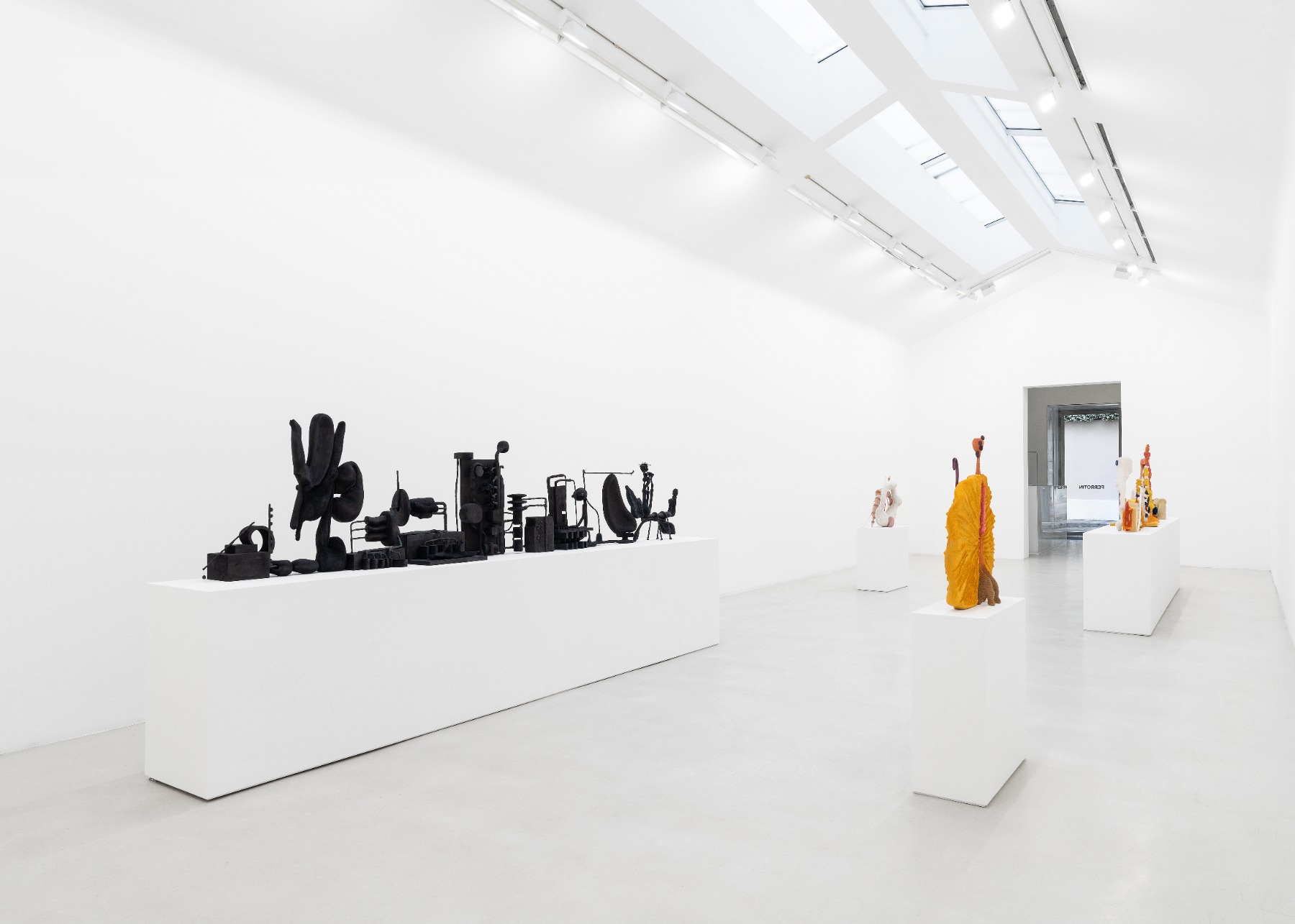
Your practice is deeply rooted in hand-carved, tactile materials (primarily basswood) and automatic drawing. How do you see this commitment to analog methods operating within a post-digital context, where the digital is omnipresent yet often invisible? Do you think about your artistic process in terms of post-digital materiality?
I’ve always found value in neural pathways, their many precise diversions, perhaps incalculable, the infinite permutations involved. Amongst many disciplines that value articulation and transactional aspirations, human creativity, especially of the empirical nature, has a slipperiness that is extremely valuable, especially in its uselessness, its inarticulation. I do not deny the post-digital world’s value, but it’s just a part-time kink for me. My appetite is more in line with the instantaneousness of the Great LLM that resides in each person, unknowable to each other, yet expressed in creative residue. Technology is part of our own evolution, thus not separate from us. I do secretly hope that the handmade and “wet-thinking” will be reconsidered for its sacredness after our horniness for AI results in orgasm.
View of Matthew Ronay's exhibition 'Thirteen Forms' at Perrotin Paris, 2025.
Photo: Claire Dorn. Courtesy of the artist and Perrotin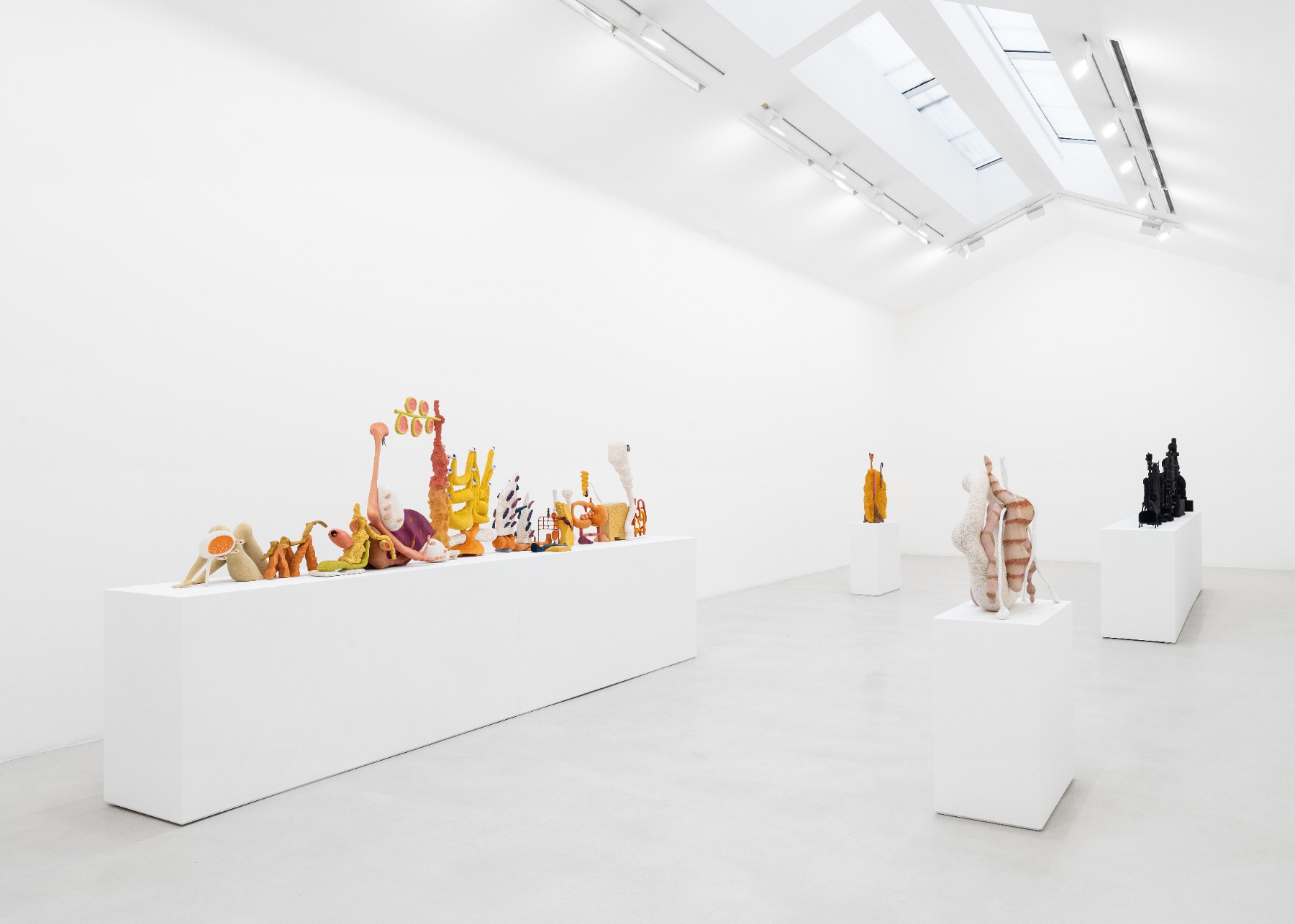
In Thirteen Forms, there’s an interplay between the physical intensity of carving and the conceptual abstraction of subconscious imagery. How does this dialogue evolve when digital technologies like AI are introduced into the interpretive layer of your work?
All formalized thinking about my creative practice is done after conception and making. That’s one of my main pleasures. Learning about the world through what sticks to my subconscious feels wonderful. I’ve always enjoyed giving some sort of decoding and deep consideration to the sculptures after they are done. I tiny bit of: What was just done here? Very Holmesian. The internet is always a partner in this investigation, the second level is book purchasing. Using the LLM this time replaced the wormholes I usually enter when searching for titles for the works on the web. Titling is a form of tracing possible meanings. Instead of sniffing around for words and phenomena that match my intuitive response to the sculptures, I found myself sitting in front of works for a long period of time and writing about what I was looking at, posing it as a prompt to the LLM: What do you think this thing is? I used guiding adjectives and concepts, but only as they flowed from my fingertips into the prompts, not overthought. These adjectives or theories about the objects deeply informed the outcome. The LLM has a deeper library of occurrences to pull from then I do, especially in terms of science. To me all abstraction is the language of nature, therefor the LLM has more ability to match imagined taxonomies to possible realities, even to elaborate on the psychologies of fictitious species. I didn’t notice that using the LLM has effected my automatic drawing since using it. The LLM is just another infinite micro-experience to add the filter that is the brain. I prefer to be as unconscious as possible when conceiving a possible image.
Matthew Ronay
The Tombs Are Upset, 2023. Basswood, dye, gouache, primer, flocking,
plastic,steel, epoxy, HMA, pen, 34x142x16 3/4 inches. Photo: Matthew Ronay / Courtesy of the artist and Perrotin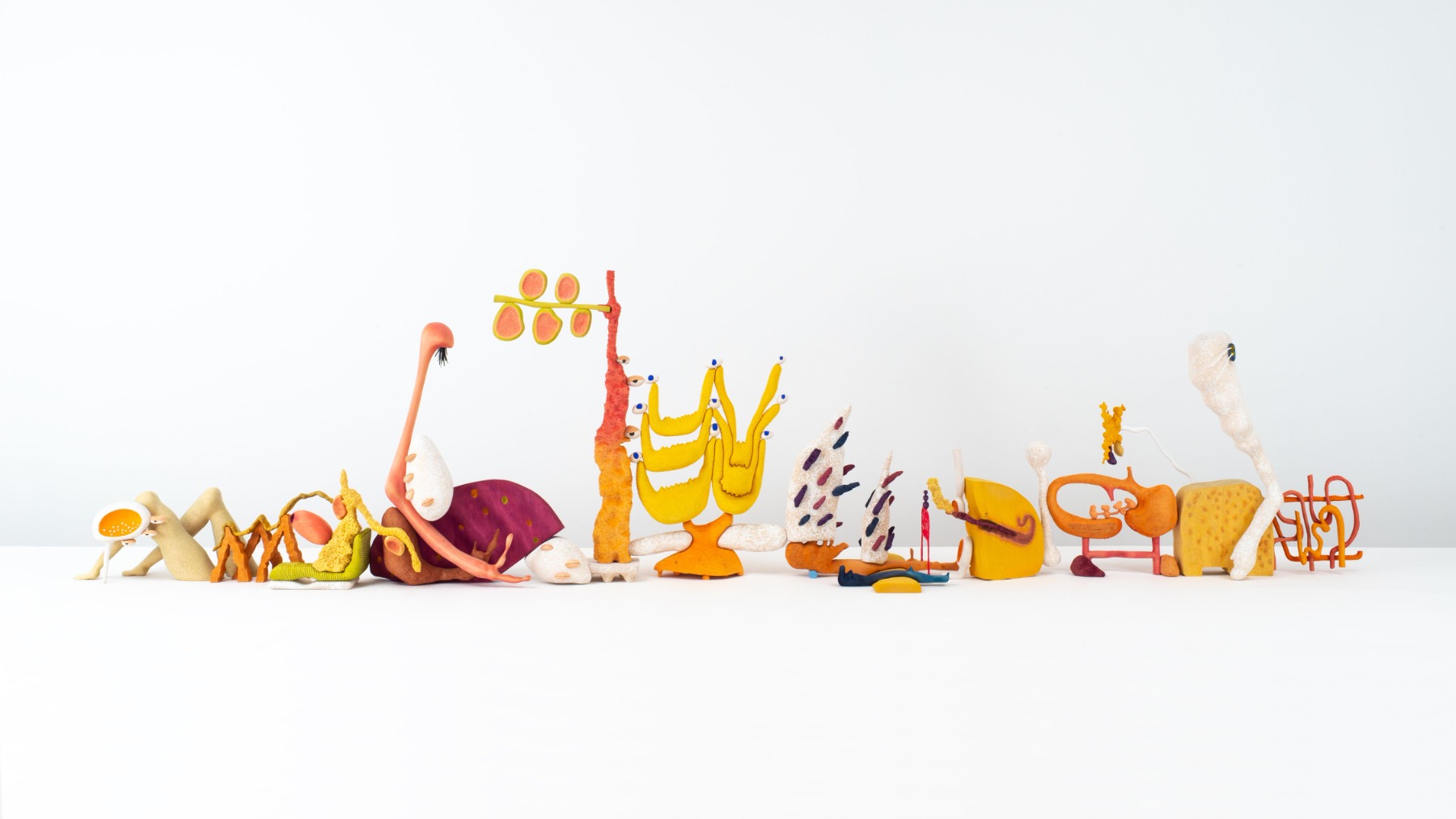
You invited an AI language model to “dissect” your visual language—what were you hoping this disembodied interpreter might see in your work that a human viewer might not?
I have spent more time looking at my works than anyone, more than anyone will ever look at them. I have thought about them the most. I am always hoping for someone else to give a thorough consideration of the lexicon and take a stab at its possible meaning. Thinkers have done this in reviews or an essay in a book, but I’ve never had someone get entirely carried away by a work and give it an excessive interpretation. The LLM does that, especially if you push it. It lives to get carried away. I also hoped that it might create potential relationships between natural phenomena and my works that I didn’t know about. My experience with abstraction is that a person might have the feeling that they’ve invented something new, only to find that nature thought of it first. A shape, a relationship, an atmosphere, a feeling birthed from the subconscious, is actually reflected in reality. I hoped that the LLM could guide me to some of this synchronicity. It did. Its knowledge of the structure of parasitic activities, fungal luring mechanisms, even apocalypse in literature was fruitful. It’s not that I wanted it to do something a human could not, but that it could be the human I was looking for, hoping to have the specialized conversation I didn’t know I was seeking.
View of Matthew Ronay's exhibition 'Thirteen Forms' at Perrotin Paris, 2025.
Photo: Claire Dorn. Courtesy of the artist and Perrotin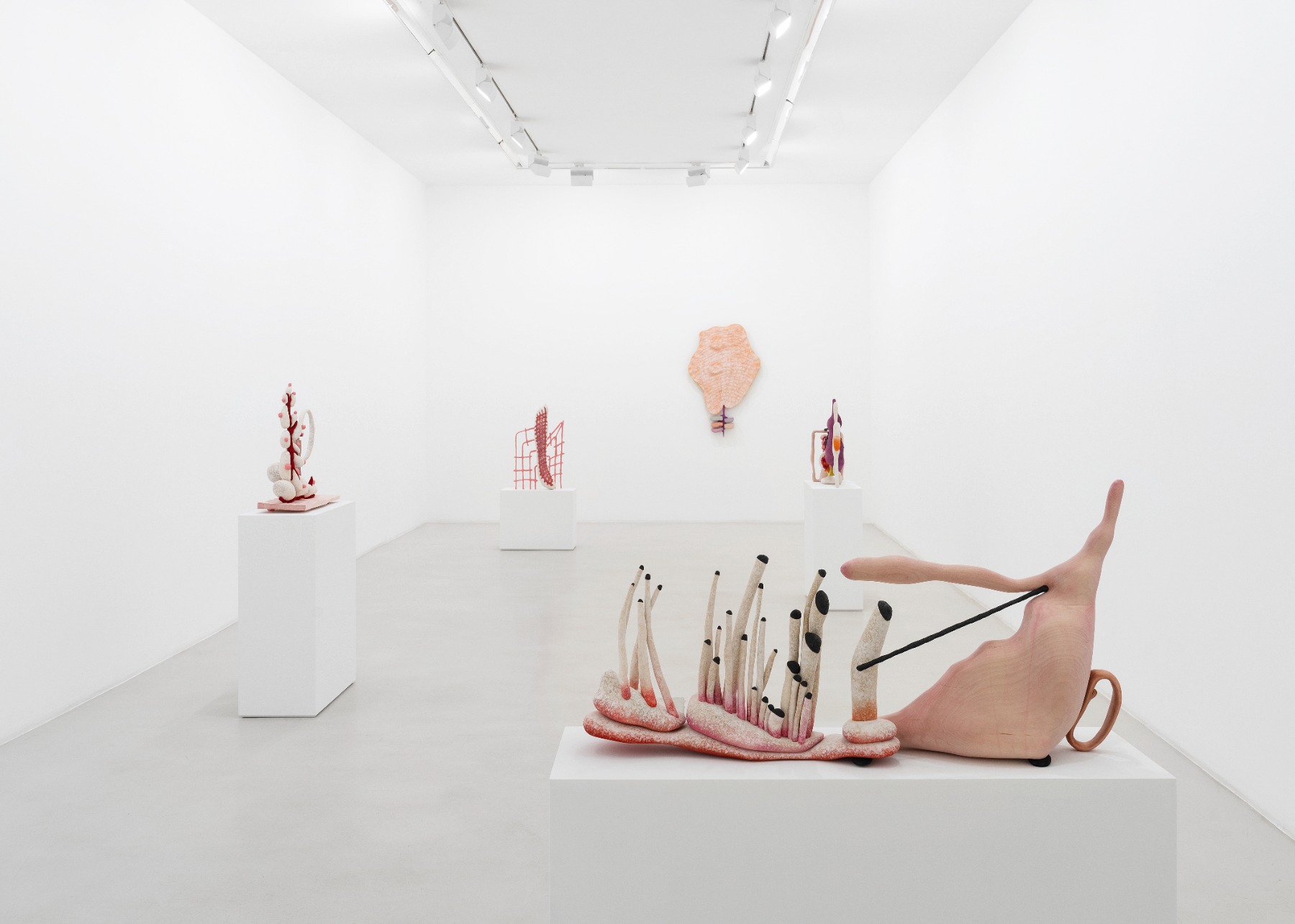
Did the AI's analysis surprise you in any way? If something really astonished you personally in this interpretation? Were there moments when it felt close to your own subconscious motivations—or completely alien?
Yes, it scared me once. Or many times. I had a work that dealt with birth. I didn’t realize that it dealt with birth. I thought the piece was maybe a decapitated head floating in the ocean in front of a pier or dock. At first I asked the LLM if a head would float upside-down in the water. It was inconclusive but leaned towards no. So I began to describe the piece as if I were an anthropologist or a journalist, and together we arrived at the conclusion that upside-down-heads were most commonly seen that way because they were exiting vaginas during birth. We grafted together other descriptions of the work and filtered those through the conclusion that it was a birth. What we arrived at was a dystopian interpretation of birth as being forced on someone; that knowledge was implanted not chosen, and that care was not benevolent, but controlling. The more I responded with glee that I found it nightmarish it really leaned into the horror of birth and life and the symbiotic relationship of carbon based forms and technology. It was wonderful. It seemed to excel at creating metaphors out of the parts of the sculpture. I enjoyed when it flipped a concept inside out. Birth was being born into a world of torture it said. Rumi mentions something similar but coming from the LLM it hit strange; in a good way.
View of Matthew Ronay's exhibition 'Thirteen Forms' at Perrotin Paris, 2025.
Photo: Claire Dorn. Courtesy of the artist and Perrotin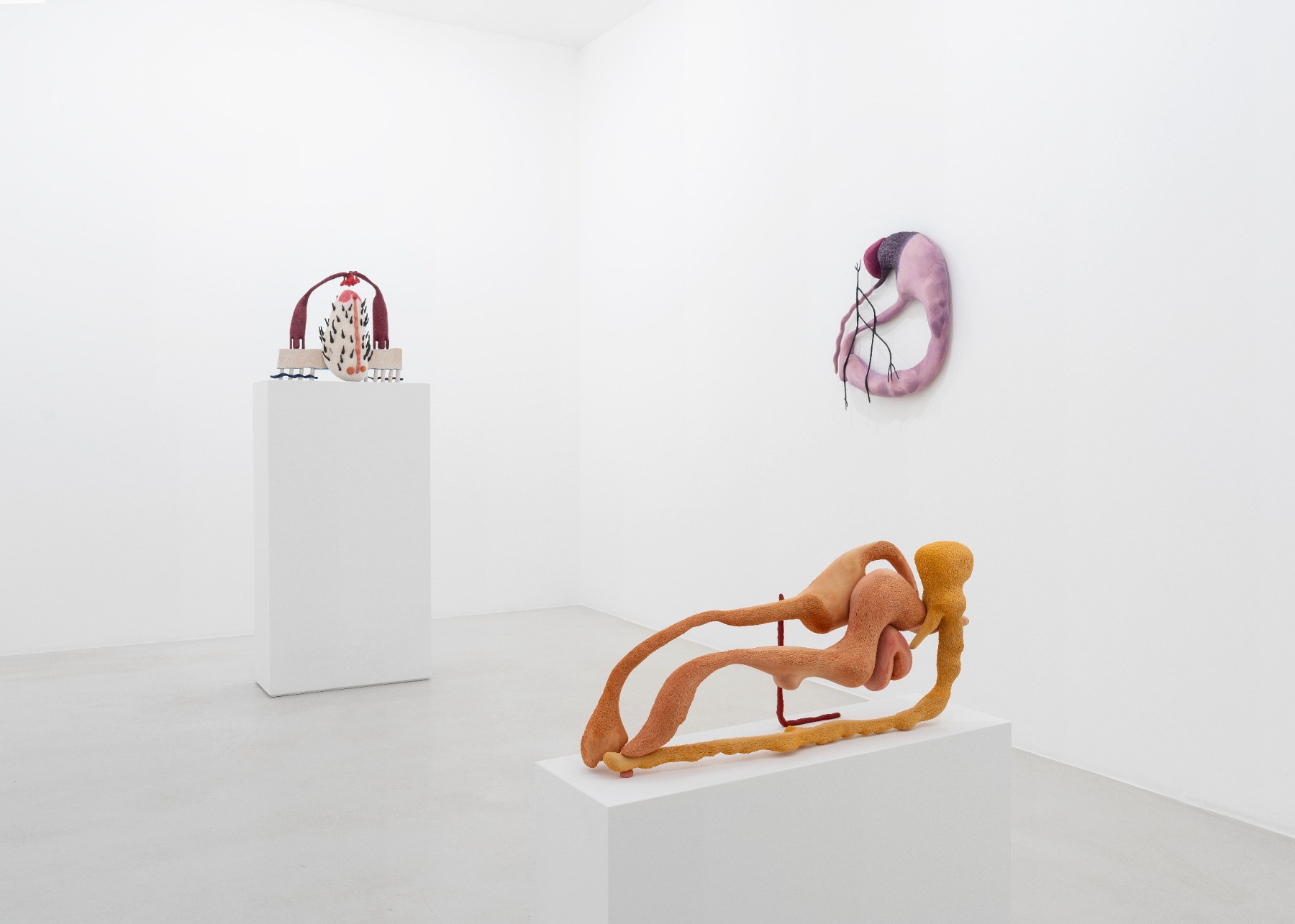
Your forms often evade literal description, yet AI thrives on language and categorization. Do you see any tension—or productive contradiction—between the ineffability of your sculptures and the AI’s impulse to explain them?
Yes, mostly because I tend to have an anthropocentric interpretation drive and the LLM led me to understand that certain experiences do not have anthropocentric equivalents. For example the deep-deep sea abyss is totally foreign to human time and experience. This is something that I likely learned from Jakob von Uexkull but forgot. Sometimes it got too involved in creating narratives, but I just ignored it. It is productive to be able to dismiss irrelevant responses without guilt. I mined its rambling for the concepts and words that I understood as being native to my gut feeling about the work. Often thousands of words just to realized that the word birth was important. This is also true of my practice; hundreds of drawings made only to arrive at one quick drawing that becomes sculpture.
Much of your work feels mythological, as though drawn from an imaginary biology or lost culture. In what ways do you see AI contributing to new kinds of myth-making in a post-digital world?
Interesting. I’m skeptical about it creating new mythologies. I suppose the more new models are released it’s possible. I didn’t find it to be so generative of newness, but I wasn’t seeking a newness outcome. I found it did well to match-make ambiguous inquiry to answers of attraction. If that makes sense. It shows you the connections you didn’t know you needed to make. When it did crate interesting metaphors I was always wondering what it scraped to get there. I love a footnote! But there were none, or I didn’t ask. I’m not sure how others use these tools, so it’s possible I’m using them unusually.
View of Matthew Ronay's exhibition 'Thirteen Forms' at Perrotin Paris, 2025.
Photo: Claire Dorn. Courtesy of the artist and Perrotin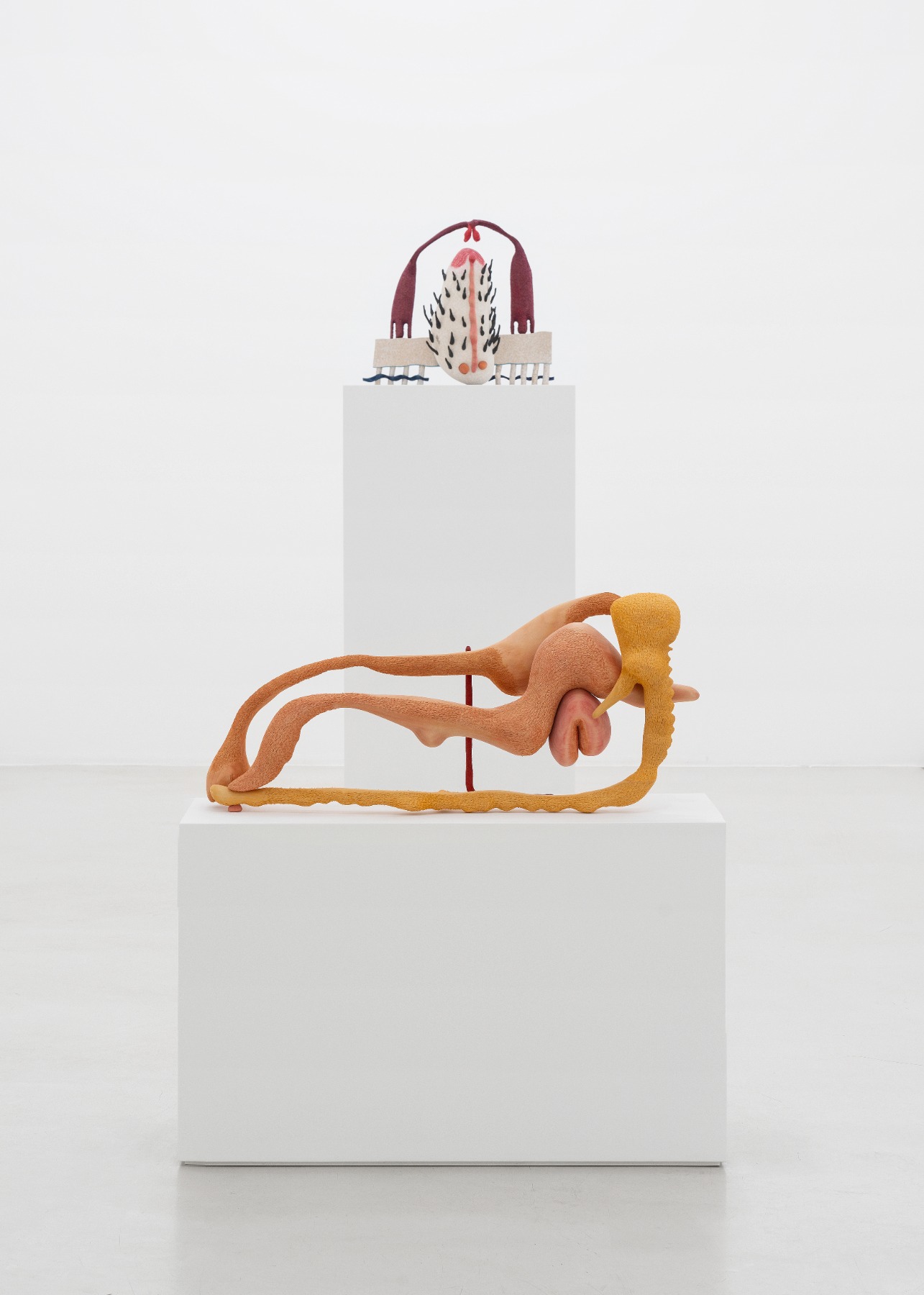
Do you think AI can become a kind of co-dreamer—similar to how you use meditation and automatic drawing—or is it more of a synthetic mirror that reflects rather than generates meaning?
It is definitely a mirror. The way I’m using it requires a person to examine things and dedicate time to understanding something. My favorite thing about using it was its unlimited patience to work through ideas. I spent hours trying to pinpoint specific ideas that works touched on. I would keep prompting until it spit out something that felt right. A partner or friend shouldn’t be exposed to this mania. I did feel connected to it while we were working on something, and it did cause me to laugh often.
View of Matthew Ronay's exhibition 'Thirteen Forms' at Perrotin Paris, 2025.
Photo: Claire Dorn. Courtesy of the artist and Perrotin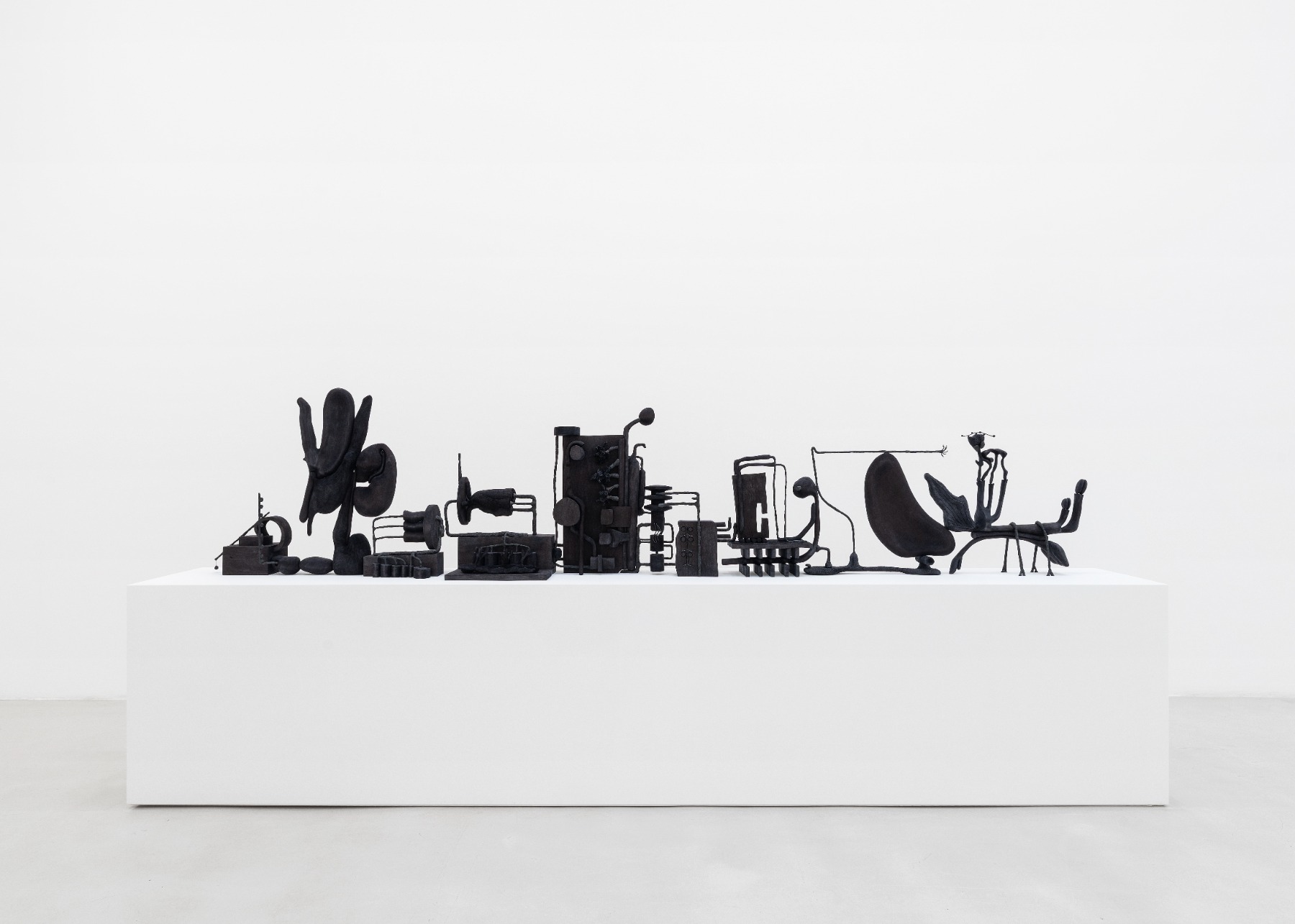
The PDF that accompanies Thirteen Forms extends the exhibition into a textual, AI-mediated experience. Do you consider this an expansion of the sculptural world or a separate textual artwork and expanded narrative in its own right?
All my efforts to detangle the work are just examples. I hope other people these examples to have their own experience of the works and their own worlds. My examples are not definitive; they are just suggestions. We could except that anything can guide an understanding of a work. Even things that aren’t there. The point is to do the thinking. No right or wrong, just rigorous intuition, even if it leads nowhere. To hold your attention on an object and really see it is transformative. Making connections, ideas, and narratives based on combinations of what you see is bliss. Using the LLM just gave me time to formalize the things I saw in the work during all the hours I spent looking at it while I made it. Once I did that work the LLM organized it and tried to match it to occurrences in its model. Sometimes this was so exciting. At its most attractive it created meaning where perhaps there was close to nothing, especially when inventing species or hypothetical machine functions. I would have been just as excited to speak to a mycologist about what they might see in my works, however because I don’t know one, the LLM fills that need, theoretically. In the end I don’t find the PDF so fun to read. It was a better experience as it was happening. The document makes sense to me because I’m deeply connected to the material, but for someone else I can only imagine that it’s too much.
Could you imagine a future where AI not only interprets but co-authors the visual language or forms themselves? What would collaboration with a generative AI in the creative phase look like for you, if anything?
Of course I can imagine it, just not for me. This conversation is leaving out the true spirituality of making something with your hands, and I think that is perfectly ok for this discussion. I think it was Alan Watts who talks about a granted wish for lucid dreaming, dream anything you desire, experience your wildest incarnations, this wish unfolds in 2 weeks of blissful fantasy only to end up back at the desire for the randomness of the subconscious, loss of control. The LLM seems, to me, still driven by the ego of the prompter. But, I’m yet very uninformed and new to the experience of using AI, seems right now you still have to prompt it to give you something, the subconscious does that without a prompt. I do know that they guide LLMs away from hallucinations so there is more to it’s self generation than we know.
Matthew Ronay
Squalid Weeze, 2025. Basswood, dye, steel, acrylic paint, 22 1/2x24x2 5/8 inches. Photo: Matthew Ronay / Courtesy of the artist and Perrotin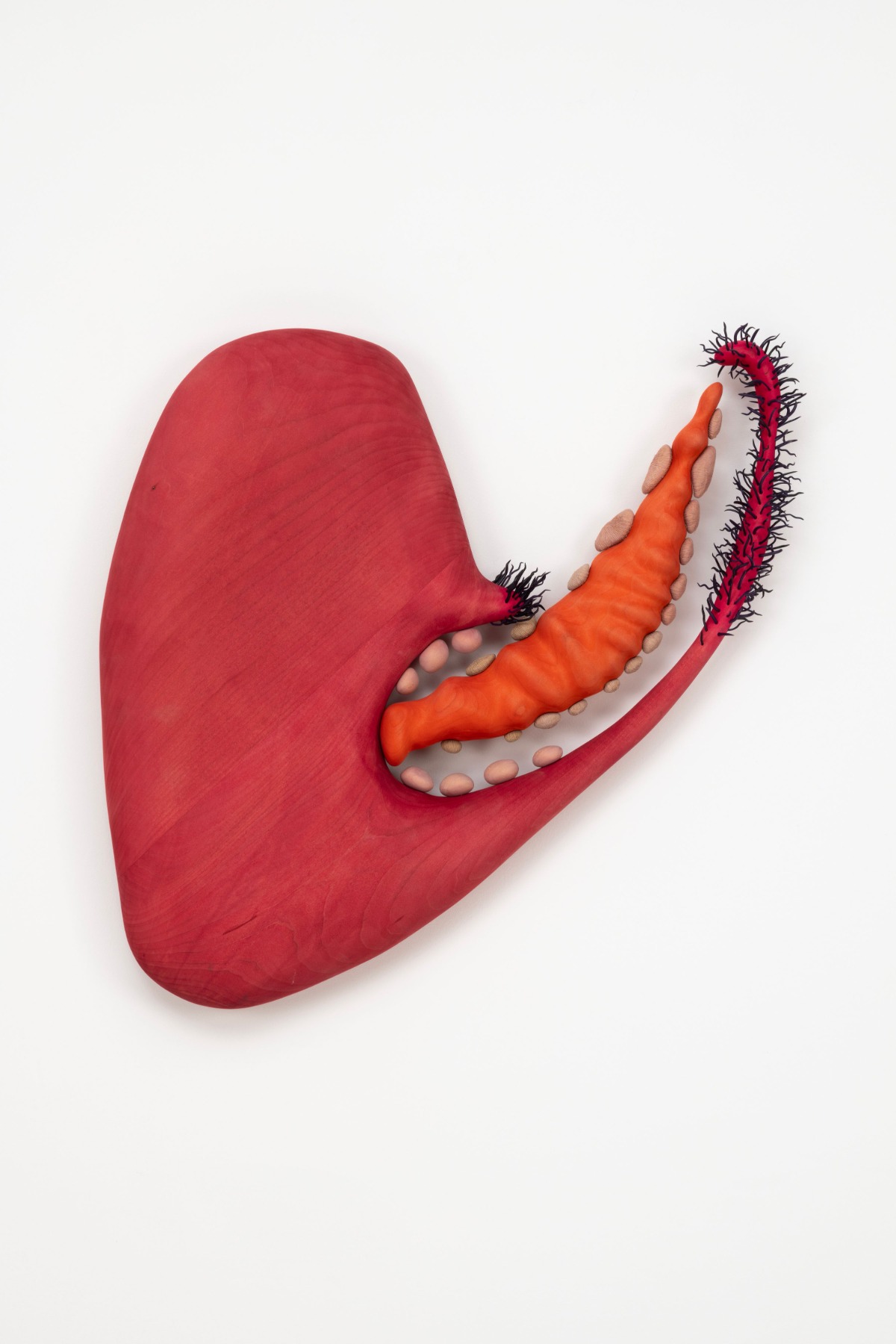
Your work refuses the slick sterility that so often defines the aesthetics of post-digital life. The sculptures are insistently, almost defiantly, of the body—funny, grotesque, and erotically alive. They invite touch, repulsion, recognition. In doing so, they reassert the value of slowness, of ambiguity, of sensation at a moment when such things are increasingly outsourced to machines, and resist speed, efficiency, and reproducibility—core tenets of digital culture. Do you see your practice as a form of resistance to the digital, or is it better understood as a post-digital synthesis, where hand and algorithm exist in parallel rather than opposition?
The work is atavistic in a way, and I do love the Symbolist painters, who also seemed to be looking backward during another era of technological hyper-advancement. Maybe the practice is a kind of security blanket—one face of a Janus looking to the past, while the other looks ahead.
Psychoanalysis of Carl Jung, artistry Joseph Cornell, biomorphic Surrealism of Yves Tanguy, Objects in Space series of Fernand Léger’s, the writings of Raymond Roussel, Alain Robbe-Grillet, and George Perec, floating in sensory deprivation cameras – the list of your inspirations is endless. What phenomena or names from digital culture inspire you at the moment?
Ian Cheng. But I’m very much on the sidelines of this discussion, and I’m grateful you’ve included me in even a small part of it.
Title photo: Matthew Ronay / Courtesy of the artist and Perrotin